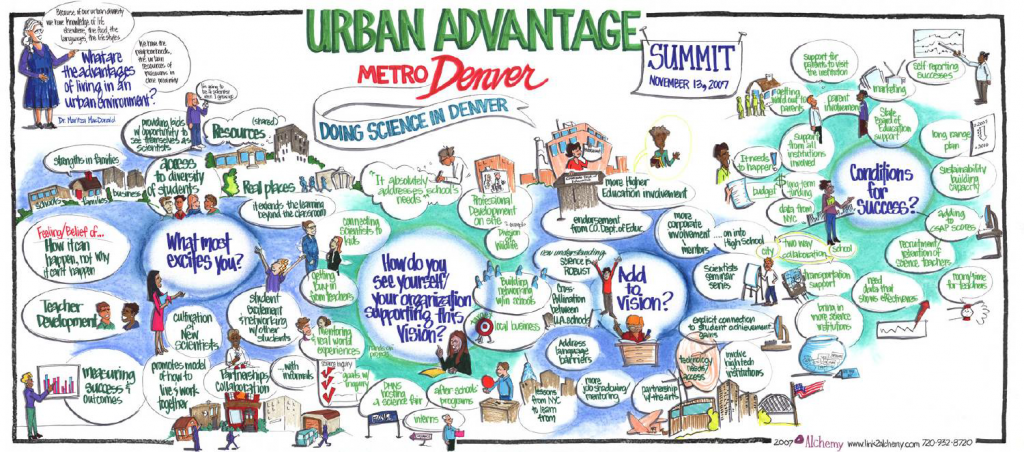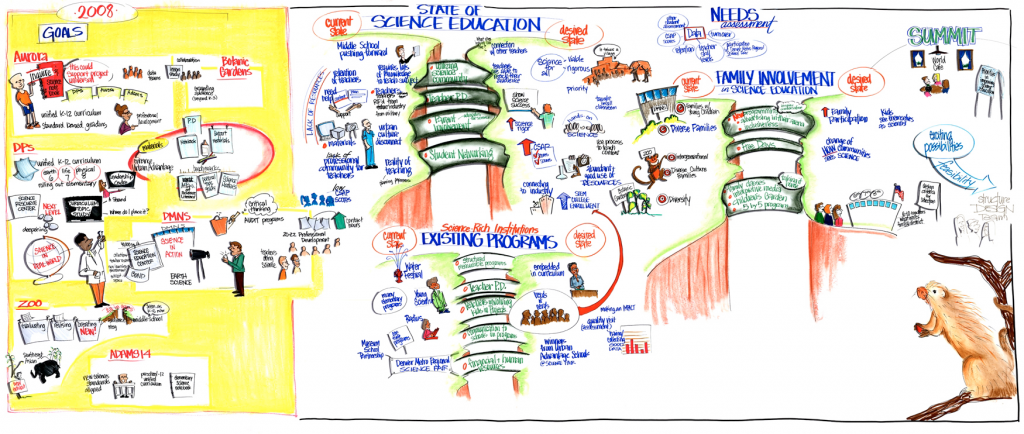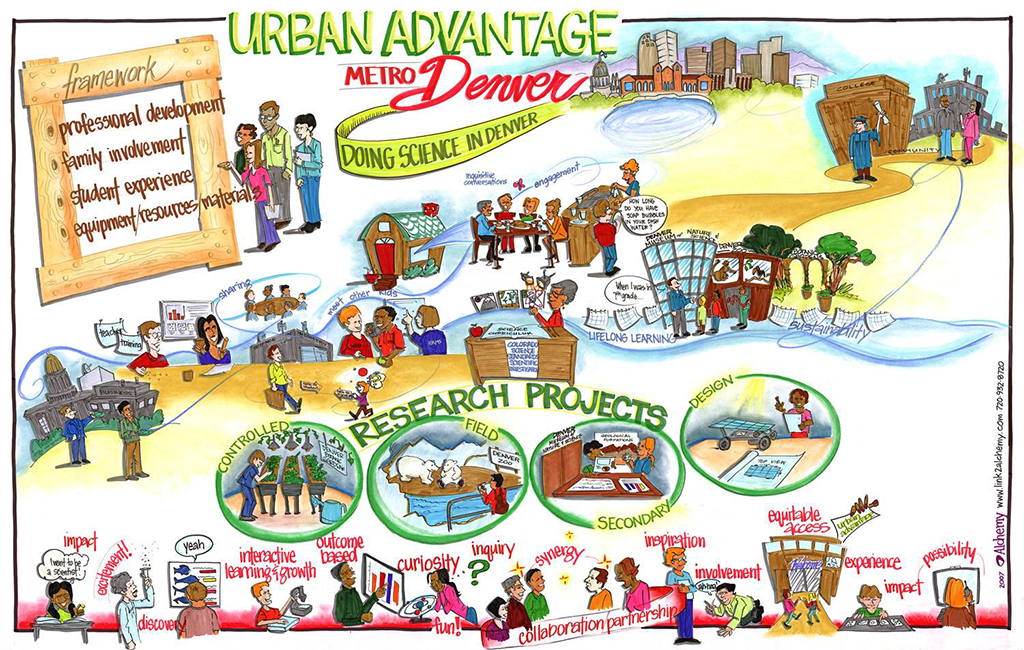Feature
When Spider Webs Unite, They Can Tie Up a Lion
A Partnership to Tackle Achievement Gaps Through Increased Opportunity
Connected Science Learning March 2016 (Volume 1, Issue 1)
By Eric Godoy, and Patricia Kincaid
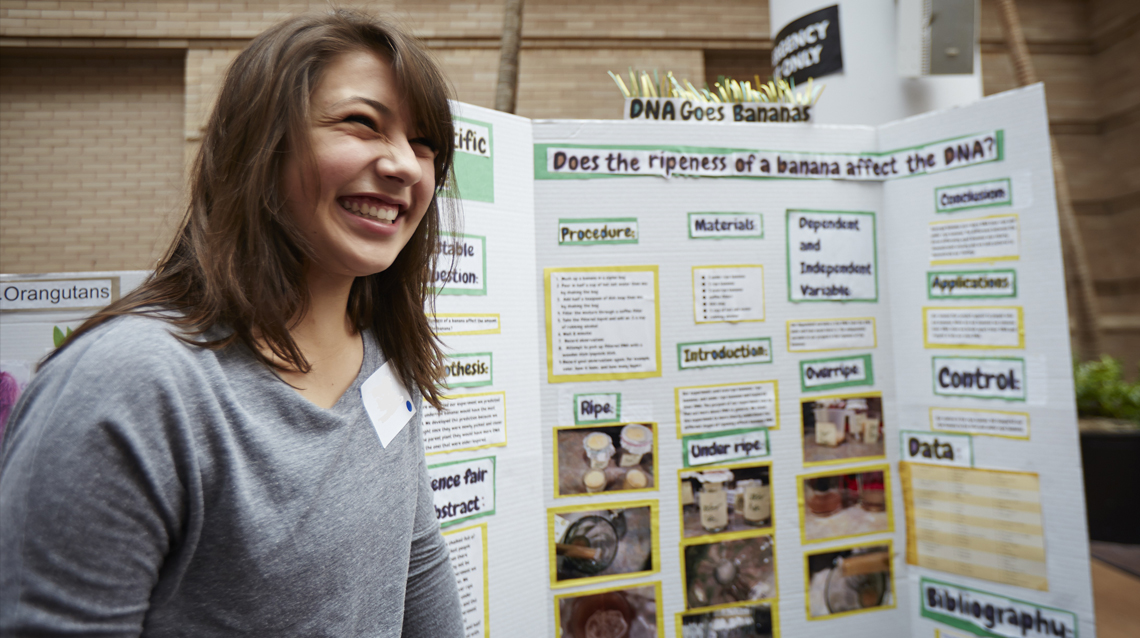
Urban Advantage Denver builds collaboration between formal and informal education partners to meet a common challenge: filling the opportunity gap for low-income, Latino, and African American students to close their growing achievement gap within formal education.
Imagine two seventh-grade students from communities of color and low socioeconomic backgrounds, of whom at least one is an English-language learner1 (ELL). Both are likely disenfranchised from avenues to success and the ability to see themselves as capable of great things.
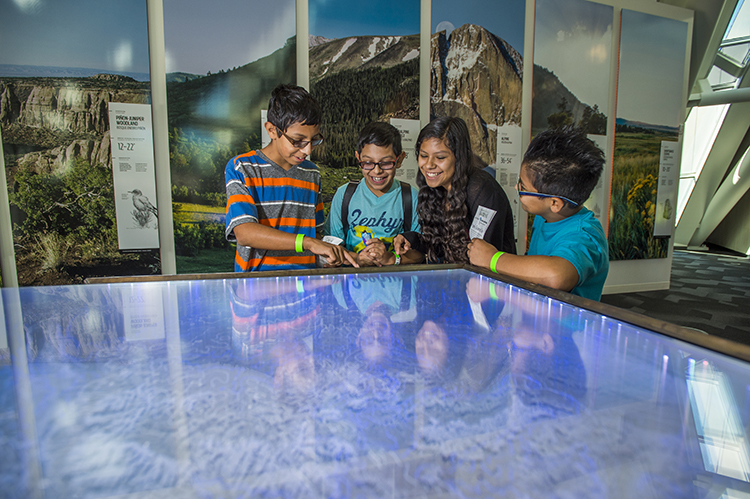
These students attend school in the largest school districts in Colorado. As part of their seventh-grade science class, they participate in a program called Urban Advantage Metro Denver (UA Denver), which provides them the opportunity to work on a self-selected science project. Their projects are inspired by field trips to three local, science-based cultural institutions, where they are challenged to embrace the experience like scientists, making observations, asking questions, and brainstorming a scientific project they can conduct, based on their own interests.
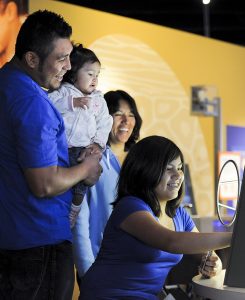
Along the way, they attend family events at their school and the organizations that encouraged them to get hands-on with science. They experience these events with the biggest influencers in their lives—their parents, siblings, grandparents, aunts, uncles, and cousins. The students and their families are having fun and exploring science, together.
The students then design a project with guidance from their seventh-grade science teachers, who received professional development and coaching on transforming their own science instruction to incorporate more inquiry-based learning methodologies. Together, the students and their teacher explore controlled experiments, field studies, and secondary research designs, and determine the projects’ topics. The students create a scientific investigation from beginning to end. They conduct research, collect data, analyze and interpret results, and make a claim based on their evidence using reasoning.
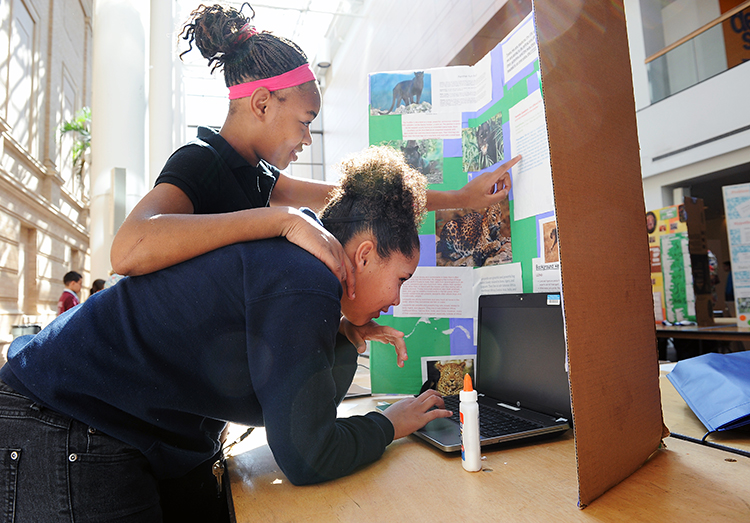
They are invited to share their investigations via trifold boards or digital presentations at a culminating student-project exposition, where they have the chance to be the world’s foremost expert on their project and share their newfound knowledge with real scientists, educators, and their peers. They stand, proud of their work, supported by their teachers and families, and confident in themselves as capable, worthy young learners. They are changed.
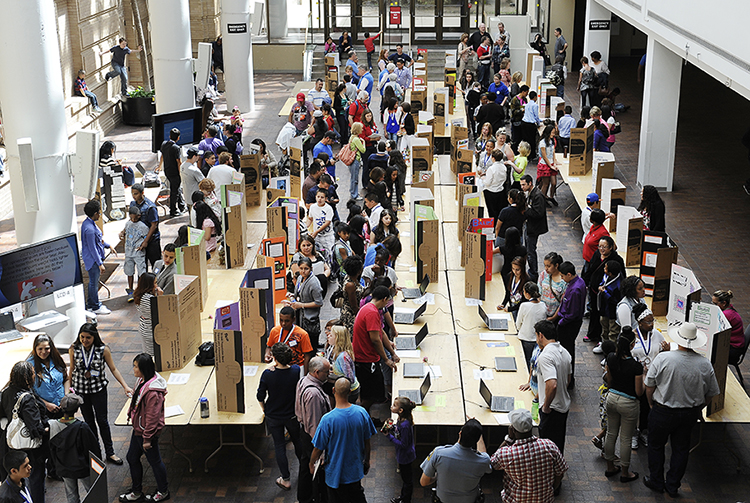
This story’s roots are authentic. Shared through an unsolicited testimonial from a teacher, this story illustrates how the UA Denver project is having a positive impact on our teachers, students, schools, and communities.
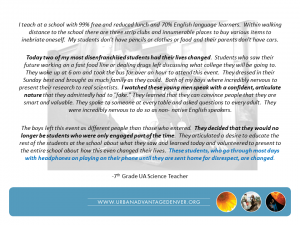
About UA Denver
UA Denver set out to build collaboration between formal and informal education partners to meet a common challenge: filling the opportunity gap for low-income, Latino, and African American students to close their growing achievement gap within formal education. The teacher’s testimonial (see photo) articulates the opportunity gaps that many urban students face, specifically the ways in which race, ethnicity, socioeconomic status, English proficiency, community wealth, familial situations, and other factors can contribute to or perpetuate lower educational aspirations, achievement, and attainment for certain groups of students (Glossary of Education Reform 2014). Through clear objectives, commitment to the student experience, shared responsibility, and leveraging our respective strengths, this partnership is uniting our spider webs of resources to confront this formidable, lionesque challenge.
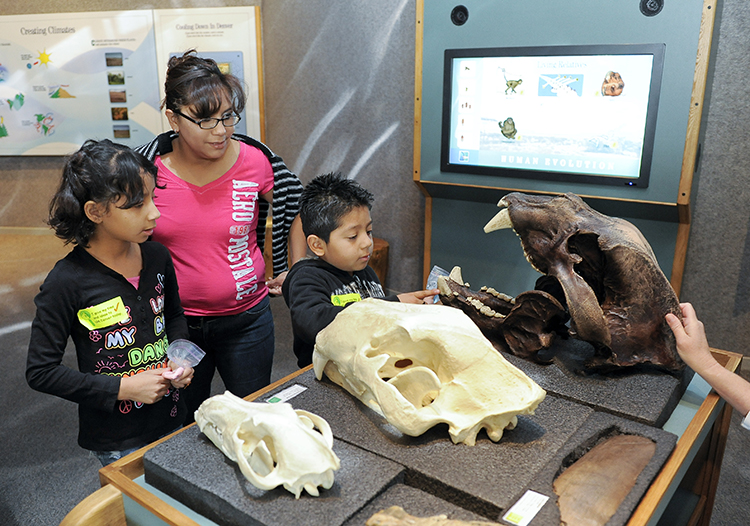
UA Denver is a collaboration among three regional informal science-education organizations (ISEs) located in a large metropolitan area—the Denver Museum of Nature & Science (Museum), Denver Zoo (Zoo), and Denver Botanic Gardens (Gardens)—and two large urban school districts (Districts)—Denver Public Schools (DPS) and Aurora Public Schools (APS). UA Denver is designed to improve science literacy and reduce science achievement gaps among middle school students by involving the student’s entire support system, including teachers and families. This initiative aims to impact three common challenges in science, technology, engineering, and math (STEM) education:
- Ensuring that all students have the opportunity to learn science-process skills, thereby addressing achievement gaps
- Enhancing teachers’ ability to provide quality STEM education. Most of Colorado’s teachers have fewer than five years of experience teaching science and often lack the confidence and expertise to help students meet science standards (Change the Equation 2012)
- Connecting learning in school with science experiences outside of school that reinforce learning, interest, engagement, persistence, and science identity
Creating the Program
The partnership was initiated in fall 2007 through a visioning conference held by Urban Advantage New York City (UA NYC), under the leadership of and with seed funding from, the American Museum of Natural History. The conference included more than 50 potential stakeholder representatives from Denver, Boston, Cleveland, Buffalo, and Miami—educators and administrators from ISEs, additional organizations offering informal-learning opportunities, administrative staff from school districts, community-organization leaders, corporations, university researchers, and government-agency representatives.
UA NYC’s program model set the example for our partnership in Denver, including its goal of tackling the growing disparities in middle school science achievement between well-resourced students and their under-resourced peers, specifically African American, Latino, and low-income students. During the convening, attendees were challenged to consider
- potential benefits of working collaboratively,
- resources each organization offered toward the project,
- assessment of the needs and desired outcomes related to the audiences served, and
- their respective organization’s ability to commit to the partnership to develop a joint feasibility study proposal for potential funding.
Eventually, the Denver-based representatives committed to pursuing local replication of the UA NYC model, leading to the current partnership of the Gardens, Museum, Zoo, and Districts (Partners). An output from this work can be seen in the “UA Summit Questions” visual map and the “UA Denver Needs Assessment” visual.
From those initial conversations, issues of equity and accessibility to learning resources and opportunities were the driving force behind the Districts wanting to collaborate with the informal science-education organizations. The ISEs were interested in collaborating with the Districts because of a desire to create more scientifically literate middle school students, an often underserved population. At the time, data from the Colorado Department of Education showed that middle school students in UA Denver Districts lagged significantly behind the state average in standardize tests for science (21% tested proficient or advanced in DPS and 26% in APS, vs. 49% statewide). For certain demographic groups concentrated in the Denver metropolitan area, the percent of students testing proficient or advanced was also well below the state average. For example, among students eligible for the free-lunch program, only 26% tested proficient or advanced. The percentage was also low for Hispanic students (25%) and ELLs (5%) (CDE 2009). UA Denver’s vision is that all middle school science students in its Districts become critical thinkers by actively engaging in authentic and meaningful science investigations, which is requisite for science literacy (AAAS 1989).
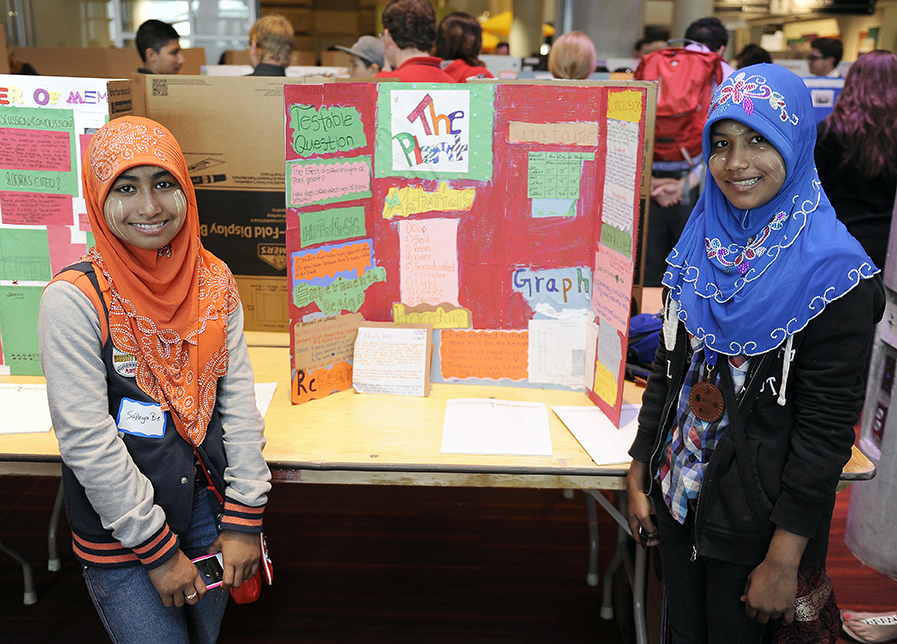
What began as an intriguing idea evolved into a program that, since inception, has served more than 14,400 seventh-grade students, provided more than 47,000 family experiences, and supported the development of 93 classroom teachers from 37 schools. The schools served during the most recent program year have an average free- and reduced-lunch rate of 74%. Fifty-seven percent of the students served are Hispanic or Latino, 14% are black or African American, and 20% are white or Caucasian. One-third of students are ELLs, and approximately 30% of families are monolingual Spanish-speakers. Initially grant funded through a research efficacy study from the National Science Foundation, we are now transitioning to a self-sustaining model funded through collaboration among the informal institutions, schools, and school districts.
Program Goals and Components
Our partnership vision encompassed these goals:
- Teachers would gain knowledge and confidence in inquiry-based methodology through professional development.
- Students would have opportunities to improve knowledge in, and get practical experience with, science processes; show increased excitement, interest, and motivation to learn science; and develop an identity as someone who knows about, uses, and can contribute to science.
- Families would better support their children’s learning.
- Students and parents would feel more comfortable using the partner ISEs as their own learning sites through access to the institutions.
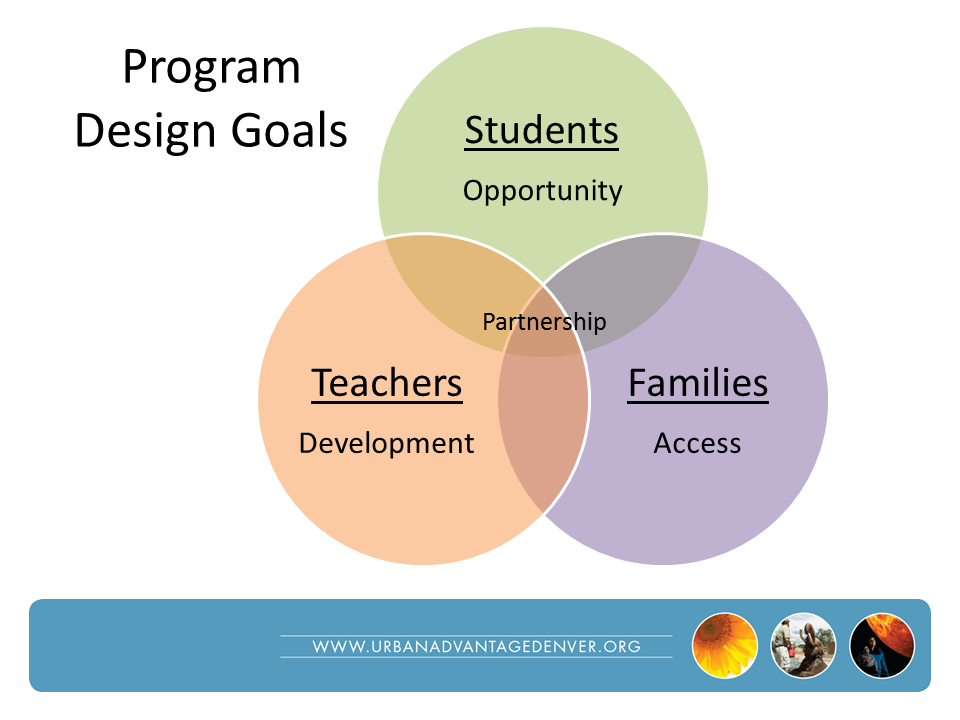
Building on the established model developed by UA NYC, we knew these goals could be addressed with a similar program framework and accompanying components, as demonstrated in the UA Denver Vision Concept (see photo).
Further planning between the Partners solidified the specific components of the UA Denver program. Through hours of planning sessions and other forms of collaborative development, the Partners devised the following program elements (see the “UA Program Components” photo for more information):
- Professional development to equip teachers with resources and skills to teach inquiry-based science that specifically addresses the science and engineering practices presented in the Next Generation Science Standards. The teacher professional-development design used the Professional Learning Community model (Mundry and Stiles 2009) and had participants experience each of the NGSS’s eight science and engineering practices both as learners and teachers.
- Student-driven, independent scientific investigations—with a focus on controlled experiments, field studies, and secondary research—in and out of school. These investigations are supported by classroom resources and are presented at a culminating exposition called Science Celebration.
- Free access to the Zoo, Garden, and Museum (via class field trips to each ISE, bus allowances, student/family passes, student help, and access to scientists), coupled with preparation for teachers and students to use the institutions as learning resources to support independent investigations.
- Outreach to keep families informed and confident in supporting their child’s education, via Family Science Days at the institutions, Family Science Nights at the schools, and an annual Science Celebration, that connects families to the institutions and celebrates their children’s science accomplishments.
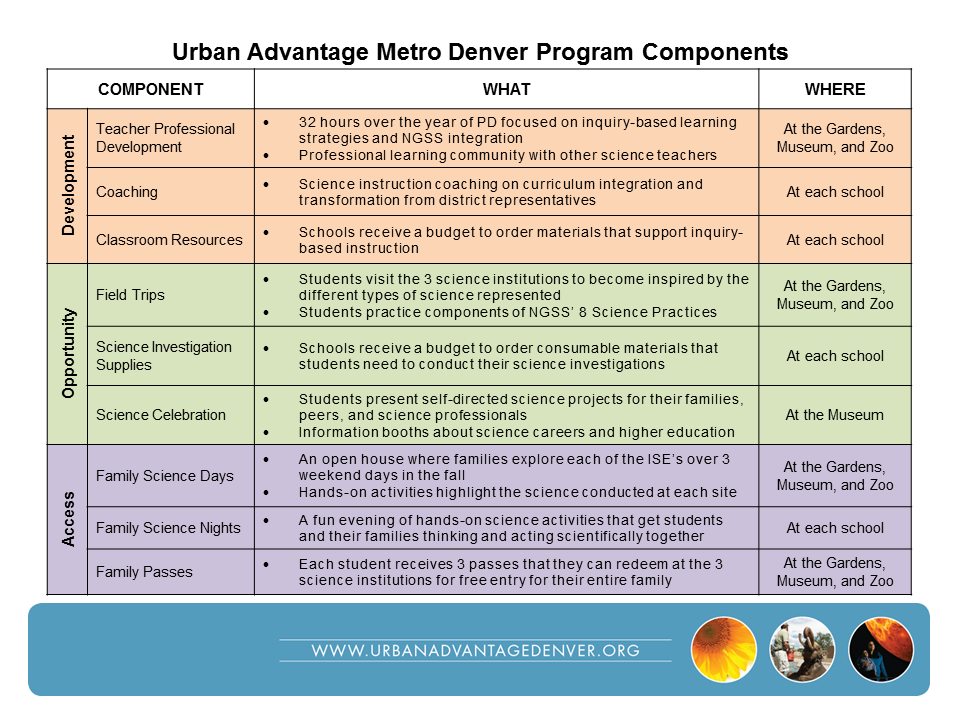
All of these activities are directed toward the end goal of supporting students thinking and acting like scientists during their yearlong, independent investigations. The UA Denver Overview video provides a summary of the UA Denver program.
Program Outcomes
Our five-year efficacy study, funded by the National Science Foundation’s Discovery K–12 Research Program (DRL #1020386), centered around determining the impacts of the UA Denver program on the target audiences: teachers, students, and families. To measure the outcomes of interest, teachers, students, and families from both UA and non-UA schools completed surveys in the fall and spring of the 2014–2015 school year, and classrooms were observed in the winter. The classroom observations used the Coding Rubric for Investigation-Related Experiences from the Inquiring Into Science Instruction Observation Protocol (Minner and DeLisi 2012). From the teacher survey, four indexes were created:
- extent to which teacher reported incorporating inquiry,
- competence incorporating inquiry,
- competence engaging students in science, and
- attitude toward teaching science.
From the student survey, two indexes were created:
- frequency of engagement in investigation-related activities in the classroom and
- likelihood of participating in science activities over the summer.
Finally, the family survey indexes created were:
- perception of the extent to which the family engages in science-related activities and supports its student in science,
- number of visits to and relationship with the partner ISEs,
- perception of impact of seventh-grade science on student’s interest in science,
- impact of seventh-grade science on family support for student in science, and
- impact of seventh-grade science on family relationship with informal science institutions.
We collected 43 teacher surveys (matched fall to spring), 43 classroom observations of teachers, 2,516 student surveys from fall and spring (506 matched fall to spring), and 2,641 fall and spring family surveys (483 matched fall to spring).
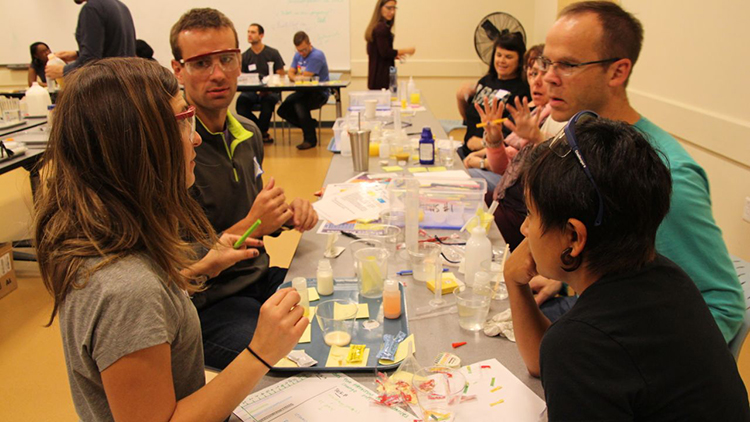
The efficacy study has determined, with both statistically significant and borderline statistically significant findings, that UA Denver is positively changing science instruction practices in the classroom. Two pieces of evidence that demonstrate change are increases in the amount of class time devoted to inquiry-based, student-driven learning practices and teachers’ positive attitudes about teaching science. Teachers returning annually to the program have shown positive cumulative effects on various measures of their inquiry-based instruction practices and make greater gains the longer they stay in the program.
For students from low-income, Latino/Hispanic and black/African American backgrounds, UA Denver is addressing the opportunity gap by providing more learning experiences (field trips, visits to science institutions) for underserved students and families compared to non-UA students. All students participating in UA Denver demonstrated more positive attitudes toward science and indicated higher interest in free-choice learning science activities (any activities outside of classroom/formal education settings). Overall, the more exposure to the program, the more positive correlation there was between student’s attitudes toward, competence in doing, and pride in their work in science, as well as likelihood of being involved in science-related, free-choice activities. Likewise, families of students with more exposure to UA activities during the course of the year reported that the program had a positive impact on their child’s interest in science; resulted in a higher level of engagement in science-related activities that supported their child in science; and the degree to which they supported their children’s science learning (see Resource for the full efficacy study “report card” of findings).
Teachers discuss their experiences with UA Denver.
Students discuss their experiences with UA Denver.
Lessons Learned
No program this large and impactful could exist without ample communication, collaboration, and coordination. We accomplish this work with a representative group, called the UA Core Team, which meets monthly throughout the year to strategize the program’s direction and implementation. Each meeting allows for a larger group, including representatives from the Partners, researchers, and evaluators, to communicate status and needs. Agendas are codeveloped, and one overall UA Coordinator leads the meeting. Implementation of the program’s components is planned by a smaller group and, lastly, teacher professional-development planning is done by an even smaller subset of the Core Team. Regular meetings serve as touchstones for the team’s goals, address emergent issues, and tap into the shared brain trust so that the program remains on course. The strength of the program’s success lies with each Partner’s commitment to meet regularly, devote the necessary staff and financial resources, and invest the energy to find common ground on all strategic directions.
Beyond the outcomes for the program’s teachers, students, and families, UA Denver has been a boon to the Districts and ISEs around learning better strategies to serve their diverse audiences. The collaborative program-design model allows the ISEs to reach a greater number of individuals and expose participants to deeper experiences than these organizations could accomplish alone. The ISEs, rather than compete for the same audience, can leverage their particular strengths to reach new audiences in deeper and more meaningful ways. This is especially true with middle school students, an often under-represented audience in informal learning settings. The resources provided by the ISEs have also expanded the Districts’ opportunities for students to engage authentically with science, putting the student at the center of the learning experience. The access component also addresses issues of equity for the underserved communities within the Districts. Finally, the Museum, Zoo, Gardens, APS, and DPS gained valuable insights into the elements of successful collaborations, such as the importance of meeting each partner’s needs, the value of codevelopment toward a common goal, the necessity of defining success and sticking to that goal, and the requirements that each group provide equitable contributions and have decision-making power.
The impact of UA Denver at the district level.
The cultural institutions involved in UA Denver.
Program design and implementation were not always seamless, and challenges did arise. For example, over the first five years of the program, there were changes in the science curriculum and leadership within the Districts; most of the ISEs underwent strategic planning that pulled priorities in new directions; and the state administered multiple, different science assessments. While these challenges required attention, the strength of the partnership and our collaborative framework allowed us to proceed unhindered.
The greatest hurdles, however, remain in front of us as we transition out of the research-based project. The future of our project depends on our continued efforts to address these program implementation challenges, as well as our ability to meet the needs of our community, maintaining flexibility in designing different models for ever-changing needs. The UA Core Team has grappled with issues including finding sustainable funding models to continuously support the program; creating multiple program models to fit different funding availability; and changing priorities and focus areas at the state, district, institutional agency, funding source, and governmental levels. For example, we’ve wrestled with questions such as:
- Would decreased funding mean the elimination of certain program components, or do we work with fewer participants?
- Should we change the core of the program if funding opportunities require a significant modification (i.e., working with schools or districts that don’t have opportunity-gap issues)?
- What is the critical mass of participants needed to keep the program financially viable?
- Should we follow the UA NYC model where 100% of program costs are covered by local government, or should we ask participating districts, and even schools, to cover portions (or all) of the program costs? And if so, what’s the magic combination?
No matter the approach we land on, we will continue to address the current needs of all stakeholders and finds ways to facilitate the attainment of their desired states.
Replicating the Partnership Model
UA Denver’s partnership model between formal and informal learning institutions is not necessarily exclusive to large metropolitan and urban settings. Nature centers, children’s museums, public gardens, zoos, aquaria, wildlife sanctuaries, science centers, natural history museums, and higher-education institutions are in almost every community. Many of these mission-driven organizations, as well as STEM-related businesses, seek to engage new audiences and address the need for a more scientifically literate population. By joining forces to address your local needs, you can tackle your community’s STEM and opportunity challenges. Once you have determined that students locally or regionally might benefit from this type of partnership, the next step is to convene all potential partners to participate in a visioning session (see “UA Needs Assessment” photo).
When convening local stakeholders, address:
- the current state of each organization regarding the programs being offered to students;
- the learning needs of your audiences—primarily the schools, districts, and informal science education organizations and secondarily the teachers, students, families, and communities;
- the type of program that would help address those needs and achieve desired states;
- the services each partner can provide to the ecosystem of the partnership to support any potential challenges;
- how partners can leverage their strengths and services to contribute to the solutions; and
- the short- and long-term goals of the project.
Based on the collaborative relationship of a partnership like UA Denver’s, each entity has its own desired goals. The magic is finding the intersection of those goals to address identified needs.
Conclusion
UA Denver welcomes the dissemination of any resources that have been developed to help personalize your own “advantage” in the development of partnerships between informal learning institutions and the formal classroom/school setting. While there are increasing challenges facing student achievement today, together formal and informal education organizations can create opportunities for students, teachers, and families to flourish. It is then that the Ethiopian proverb, “when spider webs unite, they can tie up a lion,” comes into full meaning.
Acknowledgments
All photos and videos © DMNS, except Science Pyramid, © Denver Botanic Gardens.
Eric Godoy (eric.godoy@dmns.org) is Partnership Programs Coordinator at the Denver Museum of Nature & Science in Denver, Colorado. Patricia Kincaid (patricia_kincaid@dpsk12.org) is Curriculum Coordinator for Grants at Denver Public Schools in Denver, Colorado.
Resource
For more information, go to www.urbanadvantagedenver.org or e-mail urban.advantage@dmns.org.
1 These demographics are based on statistics of participants from the 2014–2015 program year.
Equity STEM Middle School Informal Education



